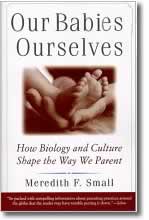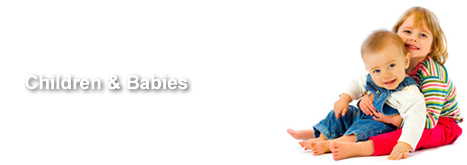Our Babies, Ourselves - Meredith Small

About the Author
Meredith F. Small is a professor
of anthropology at Cornell University and the author of Female Choices: Sexual
Behavior of Female Primates (Cornell University Press) and What's Love Got to
Do With It? (Anchor Books).
Book Description
New parents are faced with innumerable decisions to
make regarding the best way to care for their baby, and, naturally, they often
turn for guidance to friends and family members who have already raised children.
But as scientists are discovering, much of the trusted advice that has been passed
down through generations needs to be carefully reexamined.
A thought-provoking combination of practical parenting information and scientific
analysis, Our Babies, Ourselves is the first book to explore
why we raise our children the way we do--and to suggest that we reconsider our
culture's traditional views on parenting.
In this ground-breaking book, anthropologist Meredith Small reveals her remarkable
findings in the new science of ethnopediatrics. Professor Small joins pediatricians,
child-development researchers, and anthropologists across the country who are
studying to what extent the way we parent our infants is based on biological
needs and to what extent it is based on culture--and how sometimes what is culturally
dictated may not be what's best for babies.
Should an infant be encouraged to sleep alone? Is breast-feeding better than
bottle-feeding, or is that just a myth of the nineties? How much time should
pass before a mother picks up her crying infant? And how important is it really
to a baby's development to talk and sing to him or her?
These are but a few of the important questions Small addresses, and the answers
not only are surprising but may even change the way we raise our children.
Inside Flap Copy
New parents are faced with innumerable decisions to make regarding the best way
to care for their baby, and, naturally, they often turn for guidance to friends
and family members who have already raised children. But as scientists are discovering,
much of the trusted advice that has been passed down through generations needs
to be carefully reexamined.
A thought-provoking combination of practical parenting information and scientific
analysis, Our Babies, Ourselves is the first book to explore
why we raise our children the way we do--and to suggest that we reconsider our
culture's traditional views on parenting.
In this ground-breaking book, anthropologist Meredith Small reveals her remarkable
findings in the new science of ethnopediatrics. Professor Small joins pediatricians,
child-development researchers, and anthropologists across the country who are
studying to what extent the way we parent our infants is based on biological
needs and to what extent it is based on culture--and how sometimes what is culturally
dictated may not be what's best for babies.
Should an infant be encouraged to sleep alone? Is breast-feeding better than
bottle-feeding, or is that just a myth of the nineties? How much time should
pass before a mother picks up her crying infant? And how important is it really
to a baby's development to talk and sing to him or her?
These are but a few of the important questions Small addresses, and the answers
not only are surprising but may even change the way we raise our children.
Great reductions on this book from Amazon!
Excerpt. © Reprinted by permission. All rights
reserved.
Several years ago, The American Museum of Natural History in New York City sponsored
a special exhibit of human ancestors. Their goal was to bring to the public a
four-million-year record of original human fossils. These fossils are usually
locked in museum vaults in Africa, Asia, and Europe, privy only to the eyes of
qualified scientists. But that spring, the average person was going to have an
opportunity to see their ancestors, not in the flesh but in the bone. For me,
an anthropologist, this was a dream come true to see the actual fossils that
I had spent so many years studying and teaching about. I drove to New York the
first weekend it opened, excited as a teenager on a first date. I had seen photographs
of all of these fossils and played with plaster casts of many. And now I was
going to see what Louis Leakey, Don Johanson, and others had seen when they reached
down and scooped one of our ancient ancestors out of the dirt.
I walked up the main steps of the museum, passed under the banner announcing
the exhibit, and entered. It was dark, and quiet, with only a few people milling
about. The ambiance suited me--it echoed my own sense of anticipated reverence.
Before me, the first exhibit was a tall glass case lit from above. Inside was
a child's face, set high at adult eye level so that our gazes met. There was
no flesh on this skull, no eyes, no mouth, just the empty face of a child with
a set of battered teeth. I froze, sucked in my breath, and stared.
This was the "Taung Baby," a two-million-year-old Australopithecus africanus ,
discovered in 1925 and once thought to be the missing link between humans and
apes. Long ago, when this little kid died, he or she somehow ended up in a limestone
quarry where the bone tissue leaked away and was replaced by stone. Two million
years later, quarry workers chucked this hunk of rock into a box of possible
fossils that they routinely passed on to Raymond Dart, a British anatomist working
at a South African university. Dart used his wife's knitting needles to pick
away at the stone until the small face appeared. Dart was used to finding baboon
fossils in his shipment, but this was no monkey, the brain was too big and the
face was too flat. It was, Dart was convinced, the first evidence of the ape-human
split. We know now that Taung and its relatives were a kind of human that walked
upright but still had small brains, and that they were possible ancestors of
our species, Homo sapiens. A child, then, led the way to
understanding our past.
And here was that same face that Raymond Dart had looked at sixty years before.The
face is gray stone, dished in from forehead to mouth, but with a flat nose. The
eyes, were they in their sockets, would stare straight ahead. The right side
of the inner skull is filled with a geode, sparkling crystals that give Taung
a jewel-like glow. And that is appropriate. This skull, and the stone impression
of this child's brain that Dart also found, are as precious as diamonds to those
who are trying to figure out the human path of evolution. Staring at that skull,
I was struck by the fact that this ancient child was somebody's baby long ago.
Perhaps she was sick, or maybe he was accident-prone, or perhaps this baby was
some predator's dinner. Standing there, I could picture him or her long ago,
smiling, laughing, and reaching out to grab a mother's breast. It was the most
beautiful thing I had ever seen.
From a biological point of view, the Taung child represents a specific stage
of development for Australopithecines, our ancestors that lived from four to
two million years ago. Paleontologists tend to concentrate on adults of any species
because adulthood is the mature end product; but fossilized babies and children
also give clues to anatomy and physiology, to rates of development and growth.
Children are not just miniature versions of adults. There are sound evolutionary
reasons why infants and children look and behave the way they do; childhood is
a specifically evolved stage in the life course. The Taung child emphasizes the
fact that we are not born as adults but go through a lengthy period of growth
and change. In this child, and all children, are some of the most important secrets
of our anatomy and behavior. There are reasons why mice are born blind and human
babies cannot hold their heads up. Natural selection has opted for fawns to stand
on their own soon after birth, for human infants to smile automatically, and
for baby chimpanzees to cling to their mothers' fur. And all of this makes some
sort of natural biological sense. The pattern of birth, infancy, and childhood
in any species follows a particular course that eventually outlines adult biology
and behavior.
The Human Infant Design
In the summer of 1990, on a trip to Africa, I had the opportunity to hold a wild
baby chimpanzee. Its mother, and all its relatives, had been killed by a poacher.
The poacher was caught before the infant was shipped off to some European zoo,
and for now he was housed at a hotel where the sympathetic manager had made it
a policy to take in abandoned animals. Cradling the infant ape in my arms was
uncanny: she felt just like a small child, only hairier. She squirmed a bit,
looked at me with frightened brown eyes, and cooed softly, lips pouting out.
After a few anxious minutes, she stretched her long arms over my shoulder toward
the woman who usually cared for her, reaching for the only mother she now had.
That chimpanzee felt so much like a human child for a good reason--about 98 percent
of our genetic material is identical to that of chimpanzees. We are, in fact,
more closely related to chimpanzees than chimpanzees are to gorillas. I state
this fact to underscore a point: Human babies, and human adults for that matter,
are animals. We are primates, a kind of mammal, and our babies are animal babies.
Although humans like to think of themselves as unique, we share much of our physiology
and behavior with others of our kind, with other primates. For example, the shape
of our head follows a continuum with other primates that shows a reduced snout
and an enlarged brain
case with a full forehead and forward-facing eyes. Our teeth are primate teeth,
rather than dog teeth or alligator teeth. Our eyes see the way monkeys' eyes
see, with color vision and good depth perception to facilitate swinging through
the trees. And our flexible hands--the hands that can pick ripe fruit off a tree,
type these words or tie a shoe, hold a flower or build a model plane--distinguish
us, and all primates, from other mammals that have paws. Our whole upper skeleton
reflects an even closer relationship to other primates, apes in particular. Using
a human anatomy book, one can dissect a chimpanzee or a gorilla and find everything
in the right place. We have the upper bodies of long-armed apes. The only difference,
in a broad anatomical sense, is the fact that the human pelvis, legs, and feet
have been adapted to upright walking. So much of our physiology is simply that
of an upright-walking primate. The point is that human babies, like all babies,
are animals of a certain species, born with certain physical and mental abilities
and lacking some others. As this book will show, much of the animal context of
human babies and children can be understood best through the lens of biological
evolution. Taking this tack, one cannot think about babies as early unformed
organisms or shadows of the adults they are to become. They are instead simply
what they have been designed to be.
Top of Page


